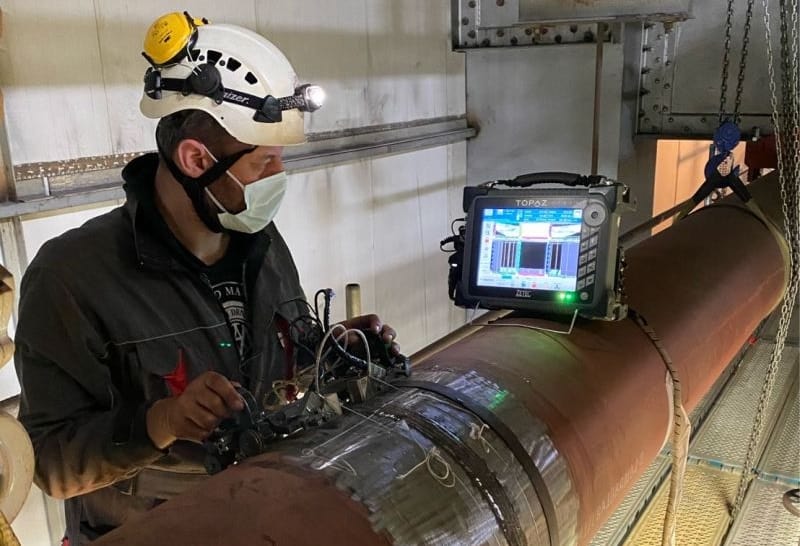Accuracy Issues: Relied On Pipeline Welding Inspection Providers for Essential Projects
Accuracy Issues: Relied On Pipeline Welding Inspection Providers for Essential Projects
Blog Article
Essential Pipeline Welding Inspection Tips for Quality Guarantee
In the world of pipe building and construction, the honesty of welds holds vital relevance to make certain the safety and security and performance of the whole system. From all-natural gas to fine-tuned petroleum products, pipelines form the lifeline of various sectors. Just how can one guarantee the high quality of these welds that link the pipeline sections? The solution exists in careful evaluation techniques and adherence to rigid high quality assurance standards. By recognizing the essential pipe welding assessment suggestions, specialists can prevent potential hazards, minimize expensive repairs, and promote the dependability of these critical frameworks.

Significance of Welding Examination
Welding assessment plays a crucial duty in guaranteeing the architectural stability and safety and security of pipeline systems. By diligently taking a look at welds, inspectors can determine any flaws or imperfections that might endanger the stability of the pipe. These inspections are crucial for avoiding leakages, ruptures, and other possibly catastrophic failures that can result in environmental damages, economic losses, and even death.
The importance of welding evaluation can not be overemphasized, as the quality of welds directly influences the overall performance and durability of the pipe. Through non-destructive testing approaches such as visual assessment, ultrasonic testing, radiography, and magnetic bit screening, inspectors can discover imperfections that may not show up to the nude eye. By identifying and attending to these concerns beforehand, welding inspection helps to guarantee that pipelines satisfy market standards and regulatory requirements.
Ultimately, welding inspection is an essential aspect of quality assurance in pipe fixing, building and construction, and upkeep (Pipeline Welding Inspection). By supporting extensive evaluation standards, industry specialists can minimize threats and maintain the security and dependability of pipeline systems
Common Welding Issues
Amongst the obstacles encountered in pipeline welding, common issues can dramatically influence the architectural integrity and performance of the bonded joints. A few of the most prevalent welding defects consist of absence of combination, porosity, fractures, incomplete infiltration, and imbalance. Lack of blend takes place when there is insufficient bonding between the weld metal and the base steel, leading to a damaged joint. Porosity, identified by gas pockets within the weld, can minimize the strength and make the weld susceptible to deterioration. Cracks in the weld can circulate gradually, jeopardizing the architectural integrity of the pipe. Incomplete penetration takes place when the weld metal does not completely penetrate the joint, causing a weak bond. Misalignment, where the weld bead is not appropriately centered, can result in stress focus factors and potential failing. Finding and resolving these common issues through extensive inspection and high quality control procedures are vital for making certain the dependability and safety and security of pipeline find this welds.
Inspection Techniques for Pipelines


In making sure the architectural integrity and dependability of pipe welds, the application of rigorous inspection methods is vital. Numerous inspection approaches are used to detect prospective flaws and make sure the total top quality of the welds. Non-destructive screening (NDT) strategies such as radiographic screening, ultrasonic testing, magnetic particle testing, and liquid penetrant testing are frequently used in pipeline welding assessment. Radiographic testing includes using X-rays or gamma rays to identify internal defects, while ultrasonic screening utilizes high-frequency acoustic waves to identify blemishes. Magnetic bit testing is reliable for identifying surface-breaking flaws, and liquid penetrant screening is used to detect surface area cracks. Aesthetic examination is also crucial in pipe welding to determine any visible issues or stoppages. In addition, automatic inspection strategies using sophisticated technologies like drones and robotics are significantly being utilized to enhance the performance and accuracy of pipeline examinations. By utilizing a combination of these examination methods, pipeline bonded quality can be ensured, and prospective concerns can be minimized before they escalate right you could try this out into larger issues.
Making Certain Top Quality Assurance Standards
To support rigorous quality assurance standards in pipeline building, careful adherence to developed sector methods and standards is important. Quality assurance in welding processes needs a detailed technique incorporating numerous phases of pipe building. Carrying out a durable high quality administration system that includes routine audits and evaluations can even more enhance the overall quality guarantee criteria in pipe welding.
Stopping Expensive Repair Services
Provided the essential significance of preserving rigorous quality assurance requirements in pipe building, an aggressive method to stopping pricey fixings this contact form is vital. Normal upkeep checks and tracking of ecological factors that might influence the integrity of the pipeline are additionally essential in protecting against costly fixings. By spending in preventative steps and prioritizing high quality guarantee at every phase of the pipe welding procedure, firms can minimize the danger of pricey repairs and guarantee the long-lasting reliability of their facilities.
Verdict
Finally, adherence to appropriate welding examination techniques is necessary for ensuring the quality and stability of pipelines. By recognizing usual welding problems and executing extensive examination processes, expensive repair services can be prevented, and high quality assurance requirements can be fulfilled - Pipeline Welding Inspection. It is essential for pipe welders to prioritize assessment treatments to keep the safety and reliability of the framework they are working with
The relevance of welding inspection can not be overemphasized, as the high quality of welds straight affects the general performance and durability of the pipe. Non-destructive testing (NDT) techniques such as radiographic screening, ultrasonic testing, magnetic fragment testing, and fluid penetrant testing are generally used in pipe welding evaluation. Aesthetic evaluation is additionally necessary in pipeline welding to determine any noticeable defects or stoppages. Furthermore, computerized evaluation strategies utilizing innovative technologies like robotics and drones are increasingly being utilized to boost the efficiency and precision of pipe assessments.In verdict, adherence to proper welding examination techniques is necessary for ensuring the high quality and honesty of pipelines.
Report this page